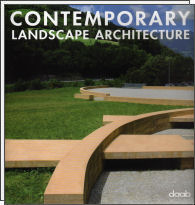 Gilbert Laing Meason first coined the term landscape architecture in Landscape Architecture of the Great Painters of Italy (London, 1828), defining it as a discipline that encompasses design, planning, management and land preservation and restoration. This classification allows the landscape architect -whose task is sometimes being "occupied" by architects themselves- to shape the terrain and the space around an already existing architectural piece or a developing urban or regional project. Gilbert Laing Meason first coined the term landscape architecture in Landscape Architecture of the Great Painters of Italy (London, 1828), defining it as a discipline that encompasses design, planning, management and land preservation and restoration. This classification allows the landscape architect -whose task is sometimes being "occupied" by architects themselves- to shape the terrain and the space around an already existing architectural piece or a developing urban or regional project.
As a result of this, the landscape architect serves as a painter or sculptor vvho tends to offer the most poetic transcription of the language associated with a given architectural calculation. The animateti (plants, trees, water, climate) and inanimate (pavement, surfaces, furniture) physical supports these professionals work with come from a geographical and socia) (urban, suburban and rural) context, in addition to some technical and economica) conditions; their imagination provides the rest to find a creative, competent and playful solution.
The aims of landscape architecture are often at the mercy of an already established urban development. In certain instances their job lies in protecting the environment or historical patrimony, or is merely an artistic statement by exhibitionist cities with the will and resources to do so. In any case, however, the design of public spaces should meet their main objective: to satisfy the demands of its socia), contemplative and recreational uses.
The fifty projects presented here primarily show the designs of new spaces and the successful restoration of others which had previously had completely different uses (industrial center, quarry, loading bay or even a penitentiary center).
Garden design, which wasn't the aim of this collection, is only presented in a more or less evident way as elements in some interior patios of condominiums, work places and parks; the bulk of the selection consists of medium size spaces that are far from the city center, built as consubstantial elements in an urban periphery development project. |
 Il termine architettura del paesaggio, è stato coniato da Gilbert Laing Meason nella sua opera Landscape Architecture of the Great Painters of Italy (Londra, 1828). La disciplina a cui il termine si riferisce riunisce in sé il disegno, la pianificazione, la gestione, la preservazione e la riabilitazione del territorio. Ciò permette al paesaggista - il cui campo di lavoro è a volte invaso dagli architetti - di modellare il terreno e lo spazio che circondano un'opera architettonica già esistente o di agire su un piano di sviluppo urbanistico o regionale. Il termine architettura del paesaggio, è stato coniato da Gilbert Laing Meason nella sua opera Landscape Architecture of the Great Painters of Italy (Londra, 1828). La disciplina a cui il termine si riferisce riunisce in sé il disegno, la pianificazione, la gestione, la preservazione e la riabilitazione del territorio. Ciò permette al paesaggista - il cui campo di lavoro è a volte invaso dagli architetti - di modellare il terreno e lo spazio che circondano un'opera architettonica già esistente o di agire su un piano di sviluppo urbanistico o regionale.
Spesso, così, l'architetto paesaggista, come un pittore o uno scultore, riesce a trascrivere nel modo più poetico il linguaggio associato a qualsiasi calcolo architettonico. Il supporto fisico con cui lavora - sia esso dinamico (pianta, albero, acqua, condizioni atmosferiche) o statico (pavimentazione, superficie, arredo urbano) - è legato a un contesto geografico e sociale (urbano, periurbano e rurale) e a dei vincoli tecnici ed economici. Il resto è affidato alla sua immaginazione per trovare una soluzione creativa, competente e ludica.
Gli obiettivi del paesaggismo sono spesso alla mercè di un piano urbanistico prestabilito che, se in alcune circostanze è volto a salvaguardare l'ambiente o il patrimonio storico, in altre è un semplice vezzo artistico per città esibizioniste che dispongono della volontà e delle risorse adeguate. Ad ogni modo, ogni piano dovrebbe comunque soddisfare un requisito fondamentale: quello di garantire un uso sociale, riflessivo e ricreativo dello spazio pubblico.
Il mezzo centinaio di progetti che qui si presentano illustrano prevalentemente il disegno di nuovi spazi o la riuscita riabilitazione di altri con un uso anteriore ben distinto (area industriale, miniera, piattaforma di carico per le navi e perfino un centro penitenziario).
ll disegno di giardini, che non è oggetto di questa collezione, è stato trattato in maniera più o meno approfondita solo come elemento associato a alcuni cortili interni di condomini o di aziende e ai parchi. I progetti presentati sono stati realizzati, per la maggior parte, in spazi di dimensioni medie distanti dai centri abitati, oppure fanno parte di uno sviluppo urbanistico periurbano. |


CONTEMPORARY LANDSCAPE ARCHITECTURE
editore DAAB
edizione 2008
pagine 384
formato 22,5x22,5
hardcover
tempo medio evasione ordine
5 giorni
39.95 €
19.90 €
ISBN : 978-3-86654-021-7
EAN : 9783866540217
|
|